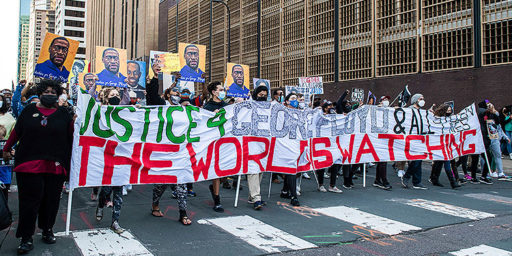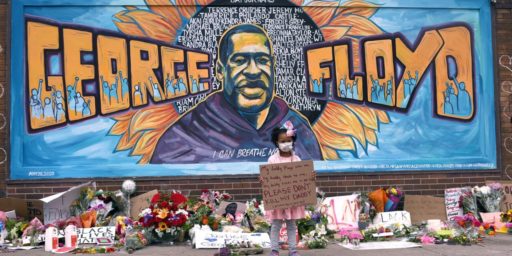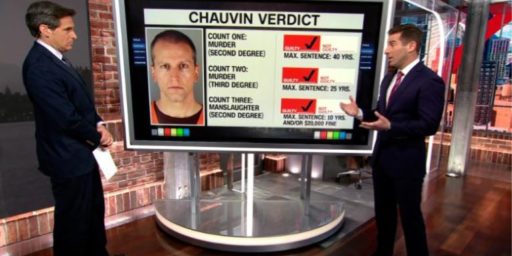Police Are Above the Law
The system makes it next to impossible to punish bad cops.

This morning’s episode of the New York Times’ podcast “The Daily” featured Shaila Dewan, a national reporter who has been covering criminal justice for paper for twenty years. The episode is titled “The Systems That Protect the Police” and subtitled “Why misconduct procedures are rarely enough to discipline officers using excessive force.”
It’s worth the 24-minute listen if you have the change. The transcript is not yet available but it’s based on Dewan’s report earlier in the week in the paper titled “Thousands of Complaints Do Little to Change Police Ways.”
The upshot is that even a progressive, reform-minded police chief faces more than half a dozen serious obstacles to punishing, much less removing, officers who commit transgressions. Indeed, Dewan believes it quite possible that the immediate firings of the four officers involved in the killing of George Floyd won’t stick. And that the prosecution of Derek Chauvin for murder will likely fail.
While I already knew much of this, I’ve never put all of the pieces together. Among the hurdles are:
- Incredibly strong protections for civil service employees in most states
- The fact that police misconduct is primarily investigated by other officers in the same police departments
- Arbitration procedures that make past leniency the standard for current decisions, such that a new chief can’t fire an officer for assault when another officer five years ago was only suspended without pay for two weeks
- Incredibly strong police unions that fight for even the worst officers lest precedent be set
- Civilian review boards that look favorably on police
- And, perhaps most importantly, a legal standard that essentially grants police officers carte blanche if they can demonstrate that they reasonably feared for their safety or that of others
As noted in the above-linked report, Chauvin had some 17 official complaints against him in his career. He received nothing more severe than a reprimand previously.
One would like to think that the sheer length of the video of the Floyd killing will overcome all of that. But I wouldn’t be shocked if it didn’t.





If I’m not mistaken, the reprimand was for tone and vulgarity, right?
—
I need to make a quick distinction before I make my point. When I say militarized police, I’m not even talking about Balko’s points, I am pointing to the structure of a police department.
They are structured like the military. Chain of Command and Ranks, etc. But discipline is not. The military justice system is separate from the civilian system. This, to me, results in a flawed process no matter what.
Military personnel are tried in front of their peers in the military. That won’t work in civil law enforcement, obviously. But the criminal justice system is likely the wrong venue for adjudication of alleged crimes of LEO. They are hardly civilians. The current system allows too many conflicts of interest to be a legitimate process.
Police exist in a state of emergency in relationship to the law. The same thing goes with gun owners and self-defense–if you’re George Zimmerman or this racist scumbag in Omaha you can chase a guy down and then be able to kill him when he fights back. The situation is always perilous, always defensible, always an exception to the rule, and everyone else has to act reasonable in relationship to this person.
It’s pure fascism and i honestly don’t believe white America can exist without the state of emergency. It’s been what–five days? Five days of demonstrations and violence? Give me a fucking break. The same people screaming about rioting were equally terrified of the 1619 Project.
Which is all the time in a country with hundreds of millions of guns.
End the drug war, start seriously reining in private weapon sales. Racism is part of the cop brain in many cases, paranoia is another part, and the means of applying that racism and fear is the drug war.
And the bad cops stick up for each other.
Anger as local police union chief calls George Floyd a ‘violent criminal’
https://www.theguardian.com/us-news/2020/jun/01/bob-kroll-george-floyd-minneapolis-police-union-chief
For those who are interested in research-based solutions to stop police violence, here’s what you need to know – based on the facts and data.
@Lynn:
Yes, the guy with 3 percenter patch. Well, allegedly.
Invalid complaints against cops are a consistent thing in DC. It is done for the sole purpose of making sure cops have a record of complaints logged against them. Cops are in a catch 22 situation. Its horrible what this idiot cop did, and what some may others do – but lets not forget the situations cops have to deal with.
Except that police are attacked far less than they were in the past. Policing is the least dangerous it’s been since we started keeping records, guns or no guns. They are being trained to be paranoid and defensive in a time when they are safer than they’ve ever been.
I’m not sure what kind of ‘reform’ works with stuff like this . You can not reform or change authoritarians.
I’ve asked before, but if there was a reply I’ve forgotten it. Could someone please point me at the precedent-establishing decisions behind this? What were the key judicial moments in the move from “the police never ever shoot first” to where we are now?
@DrDaveT: It starts with Graham v. Connor from 1989. It is called the “Reasonable Policeman standard”.
@DrDaveT:
Here’s a good backgrounder from the NYT from 2014.
The rationale is reasonable enough:
Of course, this doesn’t work when police see the very presence of black men as a fear-inducing situation.
An academic article on the subject.
Interesting study from Yale Law (pdf).
Statistics start on page 39 (40). Some interesting numbers.
To add to the challenges is that our criminal justice system is exceptionally fragmented. Not only do we have 51 different criminal codes in the US (more if we count territories and the military) but policing within states is not well regulated. In most states, each department is a force to itself. And there is limited sharing of resources.
So in the “worst case” and an officer is fired, unless their certification is fully revoked, they can move to any other department with little problems. Even then, we find that those people move into other Law Enforcement related fields (like Corrections).
Also Police Departments operate independently from Sherrif Departments which provides a significant amount of autonomy and variation within a county.
The Federal Government has chosen to take very little oversight into this regulation. The only place they typically intervene is in Civil Rights investigations and the Trump administration absolutely gutted that area (I believe they have only engaged in 1 during the last 3 years and terminated a number of the investigations and consent decrees put in place by the Obama administration).
If this is topic people are interested in I highly recommend looking into the research and policy work of Campaign Zero: https://www.joincampaignzero.org/ (they are also the source of the GREAT recommendations that @SKI linked to).
@Mu Yixiao:
Also some highly questioned numbers (often a problem when Economists attempt to interpret Criminal Justice Data).
See for example:
– https://slate.com/technology/2016/07/roland-fryers-new-paper-came-to-the-opposite-conclusion-as-a-paper-last-year-all-because-it-used-different-data.html
– https://www.washingtonpost.com/news/the-watch/wp/2016/07/14/why-its-impossible-to-calculate-the-percentage-of-police-shootings-that-are-legitimate/
So if you are going to say something is “interesting” its helpful to also point out all the problems with the study that make the numbers far less “interesting”.
There are also additional academic studies that call the findings into question, but most of those are firewall (unfortunately).
Also, we should include that the entire policing system incentivizes maintain the so-called “thin blue line.” So “good cops” are in most cases incentivized to remain silent because of how difficult it is to actually enforce penalties on the “bad cops.”
Also, to call in, I realize reading my posts on this and other threads, you’ll ask how/why I’m still voting Democrat. It’s because at least there are opportunities for something like this:
Samuel Sinyangwe is part of Campaign Zero and crafted that post that twitter thread that Ski linked to above. He knows his stuff on this.
If anyone cares about reigning in the police there is no way you can choose Trump (or any insurgent candidate) provided Biden sticks to this.
Also, if you really want to get infuriated about this topic, look into “Brady Lists” — i.e. cops who can’t be fired but also cannot be trusted to be witnesses for the prosecutor. And guess what, those lists are not shared between counties. So the best a police force can do is make it uncomfortable for a bad cop to stay and then watch as he gets a gig somewhere else and restarts the cycle.
* https://www.csmonitor.com/USA/Justice/2019/0903/When-DA-doesn-t-consider-an-officer-reliable-should-public-know
One example:
* https://www.baltimoresun.com/news/crime/bs-md-ci-cr-do-not-call-list-compel-20200211-xsjzrh2we5df7etqreyxgu2e4y-story.html
And if you want more info – and the most complete list of where different metropolitan police departments are, go to http://useofforceproject.org/
@SKI:
The unfortunate problem with that, which also is the problem with the Yale study, is reporting is all voluntary, is not verified or vetted, and many departments — especially suburban and rural — opt out. Many metro department’s reporting is incomplete (which is especially problematic because that’s where we see Policing shootings increasing in recent years).
Samuel’s team is still doing amazing work. But the state of Criminal Justice data and transparency within the US is at least two decades behind Education and Healthcare and it’s not getting better fast enough.
mattbernius- Did you see the Nature paper comparing and criticizing the methods of Fryer’s vs the Ross paper?
https://www.nature.com/articles/s41599-018-0110-z
Steve
@mattbernius:
Are they on JSTOR? The free account gets you 100 free articles a month atm.
@mattbernius:
Heh. “Testilying” is a seemingly ubiquitous portmanteau within LEO.
@steve:
I had not seen that. I am not a criminologist or a quant researcher so I cannot fully judge it, but the conclusion rang true to me based on my understanding of the topic.
@Kurtz: I didn’t realize JSTOR had finally done that. Too bad it wasn’t in time to save Aaron Schwartz’s life.
@Kurtz:
As an academic, let me show you a world:
https://sci-hub.tw/
@Mu Yixiao:
Sorry, this doesn’t pass the straight face test. There are no blond blue-eyed Tamir Rices, and there never will be.
@mattbernius: I’m pretty sure JSTOR is just doing this during the pandemic, on the grounds that’s it’s difficult to access university resources.
@Crusty Dem: Is this just a dumping ground for unreviewed research? Or is there a peer review process?
The old model sucked but made sense three decades ago. Academic societies needed someone to undertake the expensive and laborious work of publishing journals. But, now, there’s no reason for paper copies to exist at all. Just subject the paper to eding and peer review and then insta-publish all of those that meet the journal’s muster electronically.
@James Joyner:
I do get the dynamics. My biggest issue with the old system is that a lot of Social Science research was funded with Federal dollars (i.e. public money) and then was pay-walled in perpetutity. That led to it becoming increasingly insular and having little public good impact.
That said, I also think the journal industry and the drive to publish and the primary way of making tenure was actually the more problematic part of the system overall and has ultimately hurt higher ed.
I thought I’d share this as it’s relevant to the broader topics:
https://gothamist.com/news/mount-vernon-police-tapes-innocent-people-were-framed
mattbernius- I am a geeky, data nerd. I chair a medical department so I am used to reading studies. Donest mean I am perfect at it and I still make mistakes, but those kinds of studies are important. All too often you have studies of the same issue that come to opposite conclusions. You can either just decide to believe the study which supports your priors or try to find out why they are different. This study is important in addressing this particular issue. Other studies showing the police covered up stuff so the data is incomplete and knowing that a lot fo stuff never gets reported also help but this lays out the math behind the differences.
Steve
I’m sorry…but blah blah blah…
Trump got rid of consent decrees put in place by Obama.
Trump encouraged police brutality.
Trump ignored and mocked Kaepernick.
To date Trump has not addressed the real issue behind the today’s protests.
Sure there are problems with policing, there always have been. But getting rid of Trump is a first, major, step in solving this problem. Then we can get back to working on the systemetic problem that has existed forever.
@steve: My point, and I think we’re in agreement, is you just don’t link to a single study that supports your PoV. And you contextualize who did the study — in this case an Economist with no background in Criminal Justice.
No good researcher just deals with a single study. That’s why meta and comparison papers exist (like the one you listed). Completely agree that there is stuff to learn from even a bad study.
@mattbernius: True but that doesn’t impact its collection of *policies* (which is what I was trying to promote it for) and its comparison of policies between cities.
@mattbernius:
Yep. The author states that in the introduction.
I didn’t say that they’re dead-on balls-accurate (it’s an industry term). I said they’re “interesting”.
The NYC “stop & frisk” stats show that whites are twice as like to be carrying a suspicious object, 2 points more likely to “fit relevant description”, 8 points more likely to be “preparing for a crime”, and 4 points more likely to be a “lookout for a crime”.
And yet blacks are more likely to be frisked (14 pts), and less likely to have a weapon or contraband found (-1 pt). That’s something that should be looked into.
The “use of hands” by police is 4 pts higher against blacks, but all other uses of force are equal. That’s something that should be looked into.
What I find very interesting is that black officers stopped black people almost 3 times as often as did white officers (.20 vs .07)–though they initiated less than 10% of the stops that white officers did. That is a stat that needs to be looked into.
But all of this is just looking at a couple dots on a national map. We can’t have an honest discussion about police interactions–much less figure out a solution–until we have nation-wide, uniform, verifiable, and recorded data on every police interaction.
The only way to get that is to use extortion–the same way the federal government did with speed limits, BAC levels, and Real ID. All federal funds and programs to LEOs are contingent on them providing a prescribed data set, and following prescribed data-collection procedures.
Which Congress is unlikely to pass.
So we’re stuck where we are: Everyone saying they “know how it is”, and nobody knowing the actual facts.
@Mu Yixiao:
You are completely right that decades of criminologists and journalists on the Criminal Justice Beat have never ever thought to read research or share any of this.
It’s brilliant Dr Dunning-Kruger! Folks should look into these facts post haste! I’ll let all my colleagues in the Criminal Justice Reform space know that you discovered something interesting in a single, overly discussed paper (with some issues around the conclusions) from years ago that they absolutely knew nothing about.
BTW, what’s your field again, and what’s the one paper that I can read to understand all the “interesting” dynamics of it? I’m looking to change careers because clearly Criminal Justice Reform is now solved.
@Mu Yixiao:
For what it’s worth, that is the dream but there has been absolutely no interest in this from the Federal level and it’s exceptionally easy to block.
Worst still, there’s little interest in this at the state level to.
The reality of American politics is that, up until recently and only in select Prosecutor races in liberal strongholds, no one has ever lost an election for advancing a Tough On Crime platform. It’s why Bloomberg never truly disowned stop and frisk and why Biden gets twisted up on the 90’s crime bill.
Facts rarely motivate a discussion when the entire system is set up to keep scared white folks safe from apex urban minority predators.
@Mu Yixiao:
All sarcasm aside, it’s great that you found that paper helpful to you and got you thinking that there might be some surprising research out there about racial disparities and the effectiveness of our criminal justice system.
I encourage you to continue reading the lit, there is a lot of it (many great sources posted above in previous comments). I’d look into some of the congressional reports on the topic as well. And then, if you’re committed, write you state and local official about instituting some of the more data back policies for change, like the ones that Samuel Sinyangwe and others suggest.
I’ve been hearing a lot about ‘qualified immunity’ on Twitter. How does that fit into all this? Or does it?
@Katharsis:
Qualified immunity affects civil lawsuits (i.e. a cop gets sued for damages / wrongful death by a family member). Objective reasonableness affects criminal process (i.e the perspective the jury is instructed to employ in evaluating whether a cop’s actions in a given circumstance were reasonable).
@mattbernius:
Nope. That and a sense of superiority is all you’ve got.
I spent 6 years in a culture where the sum-total of all minorities is ~0.04%. They currently have over a million people in “re-education camps”. I had to let the police know where I was at all times, had to show my passport to take a shuttle bus from the airport to the town where I lived (40km away), and was subject to rules that applied only to “people like me”. Because of my race.
Taxis drove away when they saw the color of my skin. Children hid behind their mothers when they saw me. Others pointed and shouted “laowai!” (akin to shouting “Negro!”).
I’ve spent quite a bit of time discussing similar experiences with friends from Mexico, Canada, Britain, Portugal, Spain, Greece. South Korea, Belarus, Germany, Israel, Zimbabwe, and Nigeria.
So… No. I’m not some ignorant hick. Your “sarcasm” just makes you look stupid.
Yes, the S&F data is flawed and incomplete. That doesn’t make it any less interesting–or any less worth studying.
懂吗?